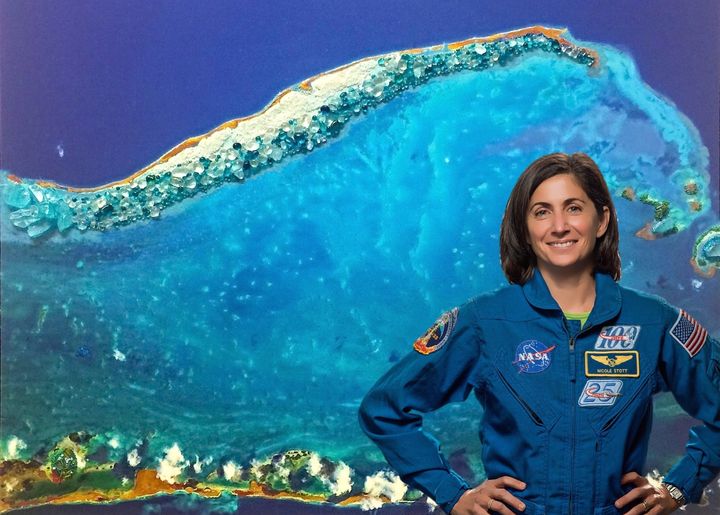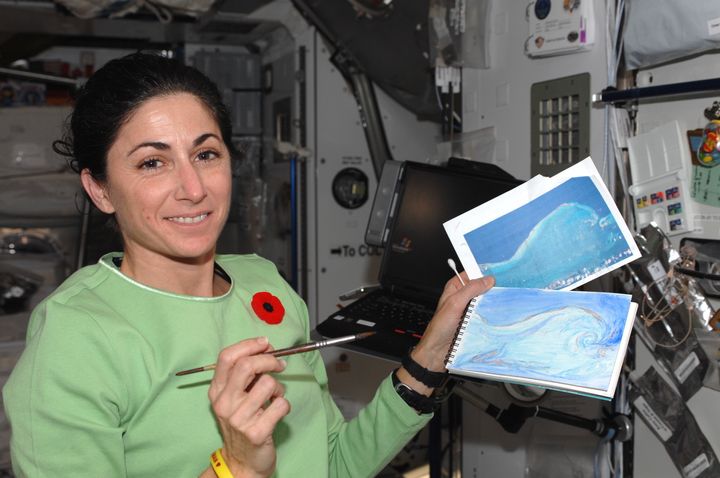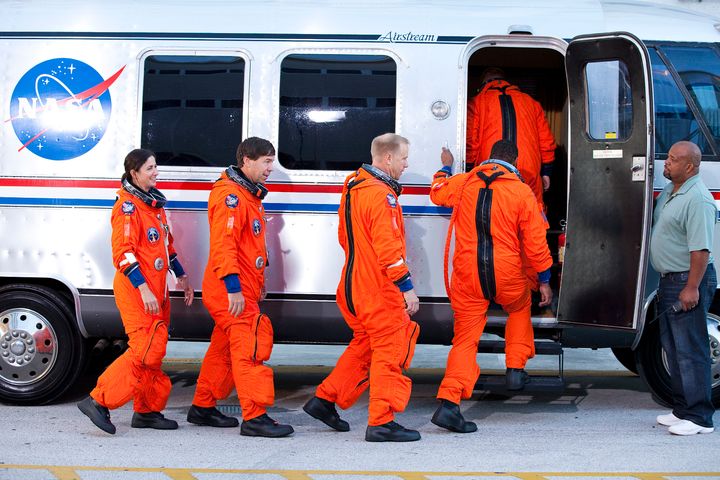

I never thought I would be lucky enough to travel into outer space and experience our world from a distance that would give me perspective about our life and mission on this earth.
Growing up, my parents always shared the things they loved with me. I was fascinated with flying. My dad built and flew small aerobatic airplanes as a hobby, so that meant we spent a lot of time as a family at the local airport. I loved flying with my dad and doing loops and rolls over the beach. I also have distinct memory of watching the first moon landing with my family and thinking how awesome it was that people were actually in space and walking on the moon I could see above me. At such a young age though it didn’t cross my mind that space was a place I would personally get to experience or that “astronaut” was a job that could be real for me.
Alongside my love of flying was a bubbling creative flair. My mom sewed most of our clothes when we were kids and also enjoyed things like macramé and ceramics, and my sisters and I were always welcome to participate alongside her. She also took me to ballet lessons and to play softball and tennis, and she took me to the airport on the weekends.
It just seemed normal to have this mix of flying and artsy stuff in my life. Little did I know that one day these two passions would combine and I would become the first person to paint a watercolor in space!
My journey into space was not a direct one. When I graduated from high school I wanted to go to college to study how things fly – this led me to Aeronautical Engineering.
About a year after graduating from college, I was thrilled to receive a call from the folks at KSC and accepted an engineering position working on the Space Shuttles. Walking into NASA on my first day was incredible, I’ll never forget the feeling that I was working at a place I’d always dreamed of. I found myself in a large aircraft hanger looking up at the belly of a Space Shuttle.
For 10 years I worked in a variety of positions on both the Space Shuttle and International Space Station (ISS) programs, and more importantly I worked with and learned from people who believed that the care and feeding of these space craft was their responsibility. For me, and the people that surrounded me, there was a passion for the program – it wasn’t just a job.

During this time it became clear to me is that 99.9% of an astronaut’s job is not flying in space. They’re training, supporting people who are in space or working on new programs. It got me thinking that the majority of an astronaut’s job is very much like what I was already doing as a NASA engineer. With that thought, a seed was planted that maybe I could become an astronaut too.
I wasn’t selected the first time of applying, but I was given the opportunity to transfer to the Johnson Space Center in Houston to gain more operational experience. I spent the next two years as a flight engineer flying on the Shuttle Training Aircraft and helping train astronaut pilots how to land the Space Shuttle. Two years later I applied again and was shocked and delighted when I was accepted!
I’m so thankful that no one ever told me I couldn’t be an astronaut – I guess I just never thought that there was anything about what I had done that would make them want to select me. It took the encouragement of people I consider to be my mentors for me to even pick up the pen and fill out the application (believe me I thank them every time I see them). I realise now that the lack of confidence I had in myself was putting self-imposed limitations on the potential of what I could achieve.
It was surreal to be picked as an astronaut and I wondered ‘why me over everyone else’, but I moved quickly past that thought knowing that my life was about to get a whole lot more amazing.

My first space flight was in 2009 and was as exhilarating as you could imagine. There was a little free time on board, and at the suggestion of one of my crew support people on the ground I brought some things to occupy that time – including a small watercolor paint kit. The feeling of floating in space and painting is something that’s difficult to describe, as you can’t do the usual things like dip your brush in water, because the water won’t stay in a cup! I had to squeeze the water in small spheres out of the straw of my drink bag. I also couldn’t paint while looking out the window because traveling at five miles per second, you can’t get the brush to the paper before the place you want to paint is out of view - so I took a picture of the place I wanted to paint and used that as my reference. Doing something creative in an environment like space is humbling and inspiring. The opportunity to paint in space is one of my most special memories of my spaceflight experience.
I was blessed with the opportunity to fly in space again in 2011 on the final flight of the Space Shuttle Discovery. We went back to the ISS, but this time for only two weeks – way too short and sadly not enough time to paint again.
Every astronaut comes home from space with the desire to share the experience in a meaningful and unique way. The opportunity to paint in space has been the inspiration for how I want to share the experience ― to use my art to help raise awareness for the amazing things we’re doing in space every day to improve life here on Earth, and to inspire more Earthling and Earth appreciation. That’s why I was really excited to participate in National Geographic’s ‘One Strange Rock’ series.
I hope people will watch the show and will be reintroduced to Earth as our home planet; that they will be in awe of how special this place we all share is; and that they will acknowledge and respect the interconnectivity, interdependence, and significance of everything from the smallest microorganism to the seemingly endless sprawl of ocean, sky, and space.
Flying in space was a life-changing experience and one that left me with a lasting perspective of our reality, which can be summed up by three simple things – the only border that matters is the thin blue line that surrounds our planet and protects us all; we live on a planet; and we are all Earthlings.
We all share this one place, this one strange rock, in space together. I’m thankful to have experienced the orbital perspective, I’m thankful to have the opportunity to use my art and spaceflight experience to share that perspective. I pray that we will all use this perspective together to create the future as Earthlings that we all deserve.
One Strange Rock airs Tuesdays on National Geographic at 8pm.
Life Less Ordinary is a weekly blog series from HuffPost UK that showcases weird and wonderful life experiences. If you’ve got something extraordinary to share please email ukblogteam@huffpost.com with LLO in the subject line. To read more from the series, visit our dedicated page.
